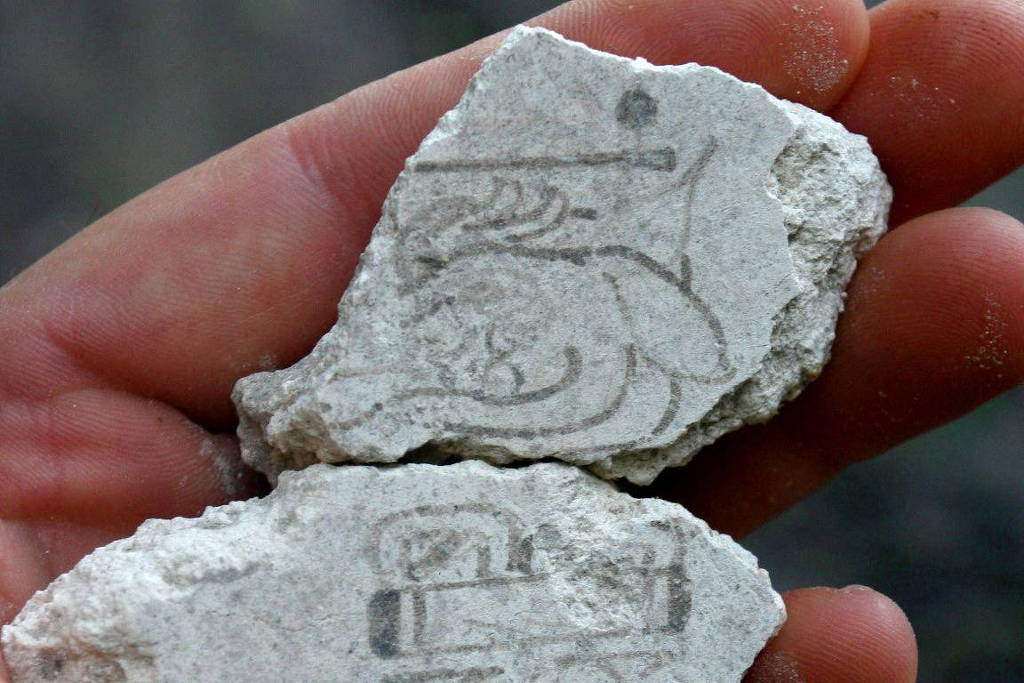A literal drawing depicting a day called “Seven Deer” inscribed on fragments of a 3rd century BC fresco found within the ruins of a pyramid in Guatemala, represents the first known use of the Mayan calendar, one of the culture’s most famous calendars. The achievements of antiquity.
The fragments were found at the San Bartolo archaeological site, in the jungle of northern Guatemala. The site is best known for the 2001 discovery of an underground chamber containing intricate colored murals dating back to around 100 B.C. depicting Mayan ceremonies and mythological scenes, researchers said Wednesday.
The fragments with the glyph of “Seven Deer” were discovered within the same Las Pinturas pyramid where the still intact murals from a later period were found. As was the case with this structure, the Maya often built temples of modest proportions and then erected larger versions successively over earlier versions. Las Pintoras pyramid reached about a hundred meters in height.
The glyph of “Seven Deer,” one of the 260 days named in the Mayan calendar, found on the frescoes consists of the number 7 drawn in ancient Maya font above the outlines of a deer’s head.
David Stewart, Professor of Mesoamerican Art and Writing at the University of Texas and lead author of research published in the journal Science progressHe described the fragments as “two small pieces of white plaster that could be held in the hand and were once attached to a stone wall.”
“The wall was intentionally destroyed by the ancient Mayas when they were rebuilding their ceremonial spaces, and it ended up becoming a pyramid. The two pieces fit together and the handwriting is drawn in black, beginning with the history of ‘Seven Deer.’ The rest is difficult to read.”
“The paintings from this stage are highly fragmented, unlike the more famous back room,” Stewart said.
To date, the most specific date of the Mayan calendar dates back to the 1st century BC.
Supported by observations of the movements of the sun, moon, and planets, the calendar was based on the 260-day ritual cycle. The 260-day calendar, called the Tzulkin calendar, was one of the interrelated Mayan systems of counting time, which also included a 365-day solar year, a larger system called the “long count” and the lunar system.
The calendar was one of the great achievements of a culture that also developed a writing system of 800 glyphs, of which the oldest examples also come from the site of San Bartolo. The Maya built temples, pyramids, palaces, and observatories, and practiced sophisticated agriculture without the use of metal tools or the wheel.
San Bartolo was a regional center during the preclassic Maya period, between 400 BC and AD 250, and this era laid the foundations for the flourishing of Maya culture during the later Classic period, known for cities that included Tikal in Guatemala, and Palenque in Mexico. and Copan in Honduras.
About 7,000 murals – some as small as a fingernail, others as large as 20 cm by 40 cm – were found in San Bartolo, and they match a “giant jigsaw puzzle,” according to a professor of anthropology at Skidmore College in New York. . Heather Hurst, co-author of the study.
The “Seven Deer” and other symbols seen on the 11 parts of the San Bartolo mural examined in the study indicate that there were mature artistic and epigraphic conventions in the area at the time, indicating that the calendar must have been in use for many years.
“It is likely that other examples will be found, perhaps even before this one, on other sites,” Hurst said.
She added, “The writing traditions represented in these eleven volumes are diverse and expressive. The technique of preparing the ink and the fluidity of the calligraphy of the scribes are impressive. It is a well-established tradition of writing and art.”
Some Mayan societies still use the ancient calendar today.
“This calendar system has persisted for at least 2,200 years, and was preserved by the Mayas during times of transformation, stress, and incredible tragedy,” Stewart commented.
Translated by Clara Allen

“Hardcore beer fanatic. Falls down a lot. Professional coffee fan. Music ninja.”







More Stories
Why can't we resist gossip? Science explains!
Genoma SUS is recruiting fellows in the fields of data science and bioinformatics
A study reveals 5 healthy fruits in the world; See what they are